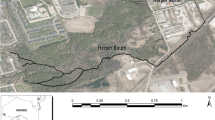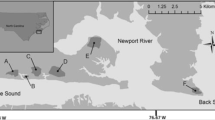Abstract
This study quantified the impact of high stream flows on reproductive activities of river chub (Nocomis micropogon). Using observed relationships between flow and reproductive activities, the number of predicted damaging flow events was compared between streams with extant river chub populations and urbanized streams. Monitoring the survivorship of river chub nests during 2013–2014 (N = 101) revealed consistent relationships between interval peak flow measured at flow gauges and the integrity of river chub nests within sites. Flow-mediated disruption of nests was frequent, and interval peak flows were significantly correlated with nest erosion rates. Logistic regression between fate of river chub nests and standardized peak flow (Qs) during monitoring intervals identified thresholds of peak flow corresponding to complete and partial destruction of river chub nests. Observed thresholds were used to predict the frequency of potentially damaging flows in urbanized versus river chub study streams, based on archival flow monitoring data. Repeated measures analysis revealed that the frequency of flows predicted to result in the loss of all nests was significantly higher in urbanized streams (F = 122.2; df = 1; P < 0.001 ). While key life history information needs to be determined to fully understand the impacts of high flows on river chub population dynamics, results indicate the disruption of nests through frequent high flows as a mechanism for the reduction of this important species in urbanized areas. Improved understanding of the interactions between stream processes and biota will aid in the design of specific stream protection and restoration strategies.




Similar content being viewed by others
References
Allan JD (2004) Landscapes and riverscapes: the influence of land use on stream ecosystems. Annu Rev Ecol Evol Syst 35:257–284
Bain MB, Meixler MS (2008) A target fish community to guide river restoration. River Res Appl 24:253–258
Barbour MT, Gerritsen J, Snyder BD, Stribling JB (1999) Rapid bioassessment protocols for use in streams and wadeable rivers: Periphyton, benthic macroinvertebrates and fish. Second Edition. EPA 841-B-99-002. U.S. Environmental Protection Agency, Office of Water, Washington, DC
Beechie TJ, Sear DA, Olden JD, Pess GR, Buffington JM, Moir H, Roni P, Pollock MM (2010) Process-based principles for restoring river ecosystems. Bioscience 60:209–222
Beisner BE, Haydon DT, Cuddington K (2003) Alternative stable states in ecology. Front Ecol Environ 7:376–382
Bernhardt ES, Palmer MA (2007) Restoring streams in an urban context. Freshw Biol 52:738–751
Bolton C, Peoples BK, Frimpong EA (2015) Recognizing gape limitation and interannual variability in bluehead chub nesting microhabitat use in a small Virginia stream. J Freshw Ecol. doi:10.1080/02705060.2014.998729
Clemens BJ, Mesa MG, Magie RJ, Young DA, Schreck CB (2012) Pre- spawning migration of adult Pacific lamprey, Entosphenus tridentatus, in the Willamette River, Oregon, USA. Environ Biol Fish 93:245–254
Cooke SJ, Paukert C, Hogan Z (2012) Endangered river fish: factors hindering conservation and restoration. Endanger Species Res 17:179–191
Dovel EL, Kemp SJ, Welker AL (2014) Predicting ecological effects of watershed- wide rain garden implementation using a low- cost methodology. J. Environ Eng 143. doi:10.1061//(ASCE)EE. 1943–7870.0000896
Etnier DA, Starnes WC (1993) The fishes of Tennessee. University of Tennessee Press
Findlay SJ, Taylor MP (2006) Why rehabilitate urban river systems? Area 38:312–325
Harman W, Starr R, Carter M, Tweedy K, Clemmons M, Suggs K, Miller C (2012) A function- based framework for stream assessment and restoration projects. US Environmental Protection Agency, Office of Wetlands, Oceans, and Watersheds, Washington, DC EPA
Groffman PM, Bain DJ, Band LE, Belt KT, Brush GS, Grove JM, Pouyat RV, Yesilonis IC, Zipperer WC (2003) Down by the riverside: urban riparian ecology. Front Ecol Environ 1:315–321
Hilderbrand RH, Utz RM (2015) Ecological thresholds and resilience in streams. In Rivers- Physical, fluvial and environmental processes (pp. 461–478). Springer International Publishing
Hilderbrand RH, Utz RM, Stranko SA (2010) Applying thresholds to forecast potential biodiversity loss from human development. J N Am Benthol Soc 29:1009–1016
Homer CG, Dewitz JA, Yang L, Jin S, Danielson P, Xian G, Coulston J, Herold ND, Wickham JD, Megown K (2015) Completion of the 2011 National Land Cover Database for the conterminous United States-representing a decade of land cover change information. Photogramm Eng Remote Sens 81:345–354
Jenkins RE, Burkhead NM (1993) Freshwater fishes of Virginia. American Fisheries Society, Bethesda
Jowett IG (1993) A method for objectively identifying pool, run, and riffle habitats from physical measurements. New Zealand Journal of Marine and Freshwater Science 27:241–248
Karr JR (1981) Assessment of biotic integrity using fish communities. Fisheries 6:21–27
Kaushal SS, McDowell WH, Wollheim WM, Newcomer Johnson TA, Mayer PM, Belt KT, Pennino MJ (2015) Urban revolution: the role of water. Water 7:4063–4087
Kemp P, Sear D, Collins A, Naden P, Jones I (2011) The impacts of fine sediment on riverine fish. Hydrol Process 25:1800–1821
Kemp SJ (2014) The potential and limitations of linking biological monitoring data and restoration needs of urbanized waterways: a case study. Environ Monit Assess 186:3859–3873
Konrad CP, Booth D (2005) Hydrologic changes in urban streams and their ecological significance. Am Fish Soc Symp 47:157–177
Lachner EA (1952) Studies of the biology of the cyprinid fishes of the chub genus Nocomis of northeastern United States. Am Midl Nat 48:433–466
Levin S (1992) The problem of pattern and scale in ecology. Ecology 73:1943–1967
Louhi P, Mykra H, Paavola R, Huusko A, Vehanen T, Maki-Petays A, Muotka T (2011) Twenty years of stream restoration in Finland: little response by benthic macroinvertebrate communities. Ecol Appl 21:1950–1961
Lukas JA, Orth DJ (1995) Factors affecting nesting success of smallmouth bass in a regulated Virginia stream. Trans Am Fish Soc 124:726–735
Luo Y, Ogle K, Tucker C, Fei S, Gao C, LaDeau S, Clark JS, Schimel DS (2011) Ecological forecasting and data assimilation in a data- rich era. Ecol Appl 21:1429–1442
Maurakis EG, Woolcott WS, Sabaj MH (1991a) Reproductive–behavioral phylogenetics of Nocomis species-groups. Am Midl Nat 126:103–110
Maurakis EG, Woolcott WS, Sabaj MH (1991b) Reproductive behavior of Exoglossum species. Bull Alabama Museum of Natural History 10:11–16
Meixler MS (2010) Application of the target fish community model to an urban river system. J Environ Manag 92:1138–1147
Miller RJ (1964) Behavior and ecology of some north American cyprinid fishes. Am Midl Nat 72:313–357
Mims MC, Olden JD (2013) Fish assemblages respond to altered flow regimes via ecological filtering of life history strategies. Freshw Biol 58:50–62
Morgan RP, Cushman SF (2005) Urbanization effects on stream fish assemblages in Maryland, USA. J N Am Benthol Soc 24:643–655
Nico L, Fuller P (2016) Nocomis micropogon. USGS Nonindigenous Aquatic Species Database, Gainesville, FL. Accessed 10/17/16 at https://nas.er.usgs.gov/queries/Fact Sheet.aspx? species ID = 577
Nilsson CJ, Pizzuto GE, Moglen GE, Palmer MA, Stanley EH, Bockstael NE, Thompson LC (2003) Ecological forecasting and the urbanization of stream ecosystems: challenges for economists, hydrologists, geomorphologists, and ecologists. Ecosystems 6:659–674
Palmer MA (2009) Reforming watershed restoration: science in need of application and applications in need of science. Estuar Coasts 32:1–17
Pendleton RM, Pritt JJ, Peoples BK, Frimpong EA (2012) The strength of Nocomis nest association contributes to patterns of rarity and commonness among New River, Virginia cyprinids. Am Midl Nat 168:202–217
Peoples BK, Frimpong EA (2012) A snapshot analysis of age distributions of fishes in urban and forested Virginia streams. Urban Ecosystems 15:927–937
Peoples BK, Tainer MB, Frimpong EA (2011) Bluehead chub nesting activity: a potential mechanism of population persistence in degraded stream habitats. Environ Biol Fish 90:379–391
Peoples BK, McManamay RA, Orth DJ, Frimpong EA (2014) Nesting habitat use by river chubs in a hydrologically variable Appalachian tailwater. Ecol Freshw Fish 23:283–293
Pirhalla DE (2004) Evaluating fish–habitat relationships for refining regional indexes of biotic integrity: development of a tolerance index of habitat degradation for Maryland stream fishes. Trans Am Fish Soc 133:144–159
Poff NL (1997) Landscape filters and species traits: towards mechanistic understanding and prediction in stream ecology. J N Am Benthol Soc 16:291–409
Poff NL, Allan JD, Bain MB, Karr JR, Prestegaard KL, Richter BD, Sparks RE, Stromberg JC (1997) The natural flow regime. Bioscience 47:769–784
Poff NL, Allan JD (1995) Functional organization of stream fish assemblages in relation to hydrological variability. Ecology 76:606–627
Power ME, Tilman D, Estes JA, Menge BA, Bond WJ, Mills S, Daily G, Castilla JC, Lubchenco J, Paine RT (1996) Challenges in the quest for keystones. Bioscience 46:609–620
Reighard J (1943) The breeding habits of the river chub, Nocomis micropogon (cope). Papers of the Michigan Academy of Science, Arts, and Letters 28:397–423
Roth NE, Southerland MT, Chaillou JC, Kazyak PF, Stranko SA (2000) Refinement and validation of a fish index of biotic integrity for Maryland Streams. Report #CBWP-MANTA-EA-00. Versar, Inc. and MD Department of Natural Resources
Roy AH, Freeman MC, Wenger SJ, Ensign WE, Meyer JL (2005) Investigating hydrologic alteration as a mechanism of fish assemblage shifts in urbanizing streams. J N Am Benthol Soc 24:656–678
Stranko SA, Hilderbrand RH, Palmer MA (2012) Comparing the fish and benthic macroinvertebrate diversity of restored urban streams to reference streams. Restor Ecol 20:747–755
Stroud water research center (2016) WikiWatershed. Accessed 11/2/16 at http://wikiwatershed.org/model/
Walling DE (1977) Assessing the accuracy of suspended sediment rating curves for a small basin. Water Resour Res 13:531–538
Walsh CJ, Roy AH, Feminella JW, Cottingham PD, Groffman PM, Morgan RP (2005) The urban stream syndrome: current knowledge and the search for a cure. J N Am Benthol Soc 24:706–723
Walters DM, Roy AH, Leigh DS (2009) Environmental indicators of macroinvertebrate and fish assemblage integrity in urbanizing watersheds. Ecol Indic 9:1222–1233
Wehling MA (2001) Land use/ land cover change from 1915 to 1999 in the Gwynns Falls watershed, Baltimore County, Maryland: Creation of a suburban social ecology. Unpubl. M. A. Thesis, Ohio University, Athens, OH
Williams SE, Shoo LP, Isaac JL, Hoffmann AA, Langham G (2008) Towards an integrated framework for assessing the vulnerability of species to climate change. PLoS Biol 6(12):e325. doi:10.1371/journal.pbio.0060325
Utz RM (2014) Are we overlooking landscape- level threats to common freshwater fishes? Fisheries 39:294–297
Utz RM, Hilderbrand RH, Raesley RL (2010) Regional differences in patterns of fish species loss with changing land use. Biol Conserv 143:688–699
Van Duzer EM (1939) Observations on the breeding habits of the cut- lips minnow, Exoglossum maxillingua. Copeia 1939(2):65–75
Violin CR, Cada P, Sudduth EB, Hassett BA, Penrose DL, Bernhardt ES (2011) Effects of urbanization and urban stream restoration on the physical and biological structure of stream ecosystems. Ecol Appl 21:1932–1949
Yingling F (1940) Fish found in Gwynns falls. Bulletin of the Natural History Society of Maryland 10:109–113
Acknowledgements
The author would like to thank field assistants Stephen Lamb (UB), Bojana Stojkovic Gut (UB), Jill Kemp, and Stanley C. Kemp; also, thanks are due to Ed Doheny and Jon Dillow (USGS), Michael Kashiwagi and Dan Boward (MD DNR), Rachel Tembly (MD DNR, Fair Hill NRMA), Magui Cardona and Marc Lennon (UB), and Charlie Davis (Natural History Society of Maryland). These studies were funded by University of Baltimore College of Arts and Sciences Summer Grants in 2014 and 2015. Thoughtful and thorough constructive comments by an anonymous reviewer greatly improved the quality of this manuscript.
Author information
Authors and Affiliations
Corresponding author
Rights and permissions
About this article
Cite this article
Kemp, S.J. Predicting impacts of urbanized stream processes on biota: high flows and river chub (Nocomis micropogon) nesting activity. Urban Ecosyst 20, 775–784 (2017). https://doi.org/10.1007/s11252-017-0641-x
Published:
Issue Date:
DOI: https://doi.org/10.1007/s11252-017-0641-x




